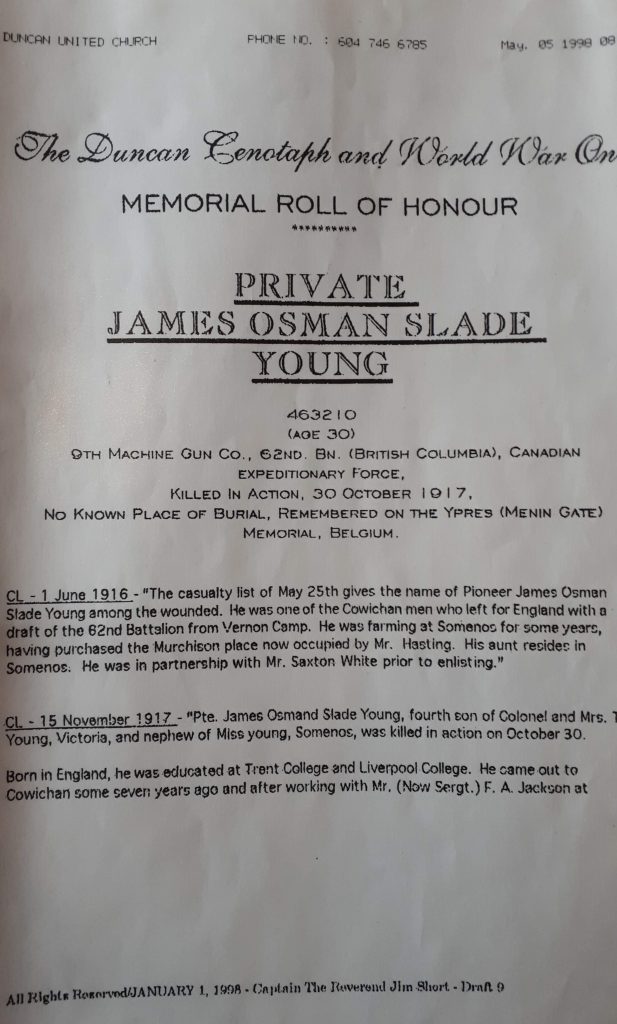James Osman Slade – b. 26 September 1887 Bootle d. 1918 France, (sometimes referred to as Joseph) also went to Greenbank School, Trent College, and then Liverpool College. It appears he travelled to Victoria before his father and family and ran the farm in Somenos after working with Mr F A Jackson at Somenos Lake for a time, but on the outbreak of war returned to England where he was offered a commission in the 2/4th Lancashire RFA but he preferred to remain with the Canadian contingent. Early in the war he was wounded at Ypres and after recovering joined the Machine Gun Corps and was only back at the front a few days before being killed on 30th October 1917, age 30. He is listed on the Duncan (BC) Cenotaph and remembered on the Ypres (Menin Gate) Memorial, Belgium.
Some more information has come to light (July 2010) from Geoff Cuthill who contacted me via this website and who is researching names on a war memorial in Liverpool. Also from the Australian Archives.
‘JAMES OSMAN SLADE YOUNG was initiated into CORONATION LODGE No.2923 at the Angel Hotel, Liverpool, on 25th November 1909, aged 22 years, a Freight Clerk, living at 18 Abercromby Street, Liverpool. He was proposed by W/Bro G.A.Harradon, P.G.D. and seconded by W/Bro. E.Henshaw W.M., and P.Pr.G.D. He was passed to the Second Degree on 23rd Dec 1909, and raised as a Master Mason on 27th January 1910.
James had been offered a Commission with his father’s old unit, the 4th West Lancashire (Howitzer) Brigade, Royal Field Artillery, (Territorial Force), but chose to stay in the ranks of the Canadians.
James had actually served in the 88th VF prior to his enlistment. Further information, according to his attestation form, gives his religion as Church of England, he stood at 5’ 7½”, 38-inch chest, fresh complexion, blue eyes, and brown hair, and it was even noted he had 4 moles on his right cheek. He sailed with the Canadian Expeditionary Force from Montreal aboard the SS Scandinavian, No 463210, Private, originally in the 62nd Btn, later transferred to CEF 3rd Pioneers, 48th Btn, arriving in England 11 October 1915 for further training, before embarking for France on 19 March 1916.
On 17 May 1916, he was rushed to No 11 General Hospital at Camiers with a gunshot wound to his right arm, received in action around Ypres. The wound was serious enough for James to be evacuated via Etaples onwards to England to the Auxiliary Military Hospital in Southall, London, and then to Southern Hospital, Liverpool. This would have allowed friends and family to visit James in hospital, particularly his father, and this would have been the first time many had seen him since he had moved to Canada. He stayed a month in Liverpool before moving, on 31st July, to the Canadian Convalescent Hospital at Epsom, Southern England, until his discharge as fit to return to unit on 13th September 1916.
He was transferred to the 25th Res Btn for training and was awarded his Good Conduct Badge on 3 August 1917 at Seaford, and was passed as a Machine Gunner, and posted back to France/Flanders, arriving at Camiers on 3 September 1917, and was sent to 9th Canadian Machine Gun Company, 3rd Div on 20 September.
James was back again within the Ypres Salient and involved in the 3rd Battle of Ypres, what we know better as the Battle of Passchendaele. On the morning of 30 October, James and his comrades were waiting for the signal to attack the village of Passchendaele, the battle for the village being fought since 31st July; it was 5.45 am, when the Germany Artillery bombarded the narrow Canadian front. Within five minutes, the Canadians moved forward at zero hour. By noon, the rain was falling in torrents, the troops now moving forward knee-deep in mud. The German bunkers, some of them still holding out, were by now surrounded by mounds of dead Canadians, who had advanced to within 500 yards of the village centre. Such was the scene in which James lost his life on Tuesday 30 October 1917.
James has no known grave, and is commemorated on the Duncan Cenotaph, British Columbia, Canada; the Menin Gate, Ypres (Ieper), Belgium; the Liverpool College Memorial, Queens Drive, Liverpool; the Liverpool Masonic Hall Memorial, Hope Street, and the Masonic Roll of Honour Book of the United Grand Lodge, England. ‘
